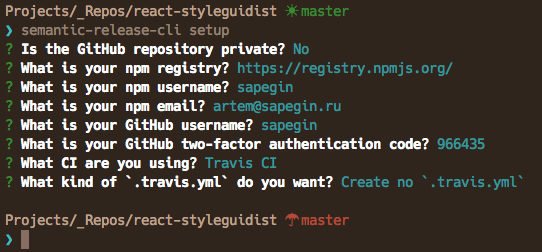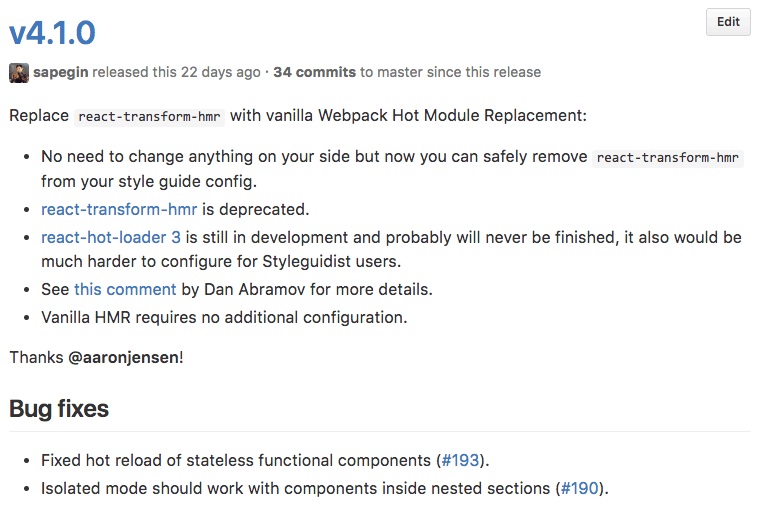Automate npm releases with semantic-release and human-written change logs
Making new releases is one of the most boring and tedious tasks in open source.
There are many tools that try to automate publishing and one of the most interesting is semantic-release. I was avoiding it for a long time because it makes publishing fully automated with changelogs generated from commit messages, and that I thought that changelogs must be written by humans.
But actually it’s very flexible and I was able to customize it to do exactly what I want:
- Publish a new PATCH version to npm as soon as a fix commit merged to the
masterbranch, generate changelog from commit messages. - Postpone MINOR and MAJOR release until a proper changelog is written by a project maintainer.
- Generate changelog draft: Markdown file with all important commits since the latest release grouped into three sections: breaking changes, new features and bugfixes.
Below I’ll describe my own set of scripts that implements this workflow.
How it works
-
Semantic-release runs on a CI server.
-
After each successful build it analyzes new commits and see if there’s something to publish.
-
It determines a release type (PATCH, MINOR or MAJOR) by analyzing commit messages (more on that later).
-
It generates a changelog:
a. If the release type is PATCH: from commit messages.
b. If the release type is MINOR or MAJOR and the latest commit is a changelog: uses body of that commit as a changelog.
-
Publishes a new version to npm.
-
Publishes changelog to GitHub Releases page.
Install semantic-release
First install semantic-release command-line tool:
npm install -g semantic-release-cliThen run it in your project folder:
semantic-release-cli setupEnter your npm and GitHub credentials. Choose “Create no .travis.yml” if you already have one, otherwise it will be overwritten.

Add these lines to your travis.yml:
after_success:
- npm run semantic-release
branches:
except:
- /^v\d+\.\d+\.\d+$/Customize semantic-release
You can change semantic-release behavior with plugins: detect release type, check release requirements (like a changelog), generate changelog, and so on I made a package with all plugins I need to support my workflow.
First install the plugins:
npm install --save-dev semantic-release-tamiaThen add to your package.json:
"release": {
"analyzeCommits": "semantic-release-tamia/analyzeCommits",
"generateNotes": "semantic-release-tamia/generateNotes",
"verifyRelease": "semantic-release-tamia/verifyRelease"
}Run npm install and npm run semantic-release to test if everything works. You’ll see something like that:
semantic-release WARN pre semantic-release didn’t run on Travis CI and therefore a new version won’t be published.
semantic-release WARN pre You can customize this behavior using "verifyConditions" plugins: git.io/sr-plugins
semantic-release ERR! pre Failed to determine new version.
semantic-release ERR! pre ENOCHANGE There are no relevant changes, so no new version is released.Which is fine and means two things: semantic-release will not make a release until it runs in a CI environment and you have no changes that could be published.
Use Git commit message convention
By default semantic-release uses Angular conventions which I don’t like aesthetically. So I use a slightly modified convention:

Each commit message consists of:
- Type:
Featfor new feature,Fixfor bugfix, and so on - Subject: short change description.
- Body (optional): long change description.
- Footer (optional): breaking changes, GitHub issues references, and so on
Semantic-release uses this tags to find all important commits for the release (Fix is important, Docs is not) and determine which version (MAJOR, MINOR or PATCH) should be released.
Write changelog for MINOR or MAJOR release
I wrote a script to help me with changelogs.
First run sr-changelog. It will create a file with all important commits for the release grouped by type (breaking changes, new features and bugfixes) and open it in your default editor.
Now you can rewrite your changelog to make it useful and easy to read for your users.
Then run sr-changelog commit. It will make a commit without changes (git commit --allow-empty) of type Changelog and changelog in the commit message body.
Publish new release
Now you need to git push your changes and make some coffee.

Caveats
-
Do not merge pull requests, squash them into a single commit with a proper message.
-
If you forget to do that and want to make a PATCH release:
git commit -m "Fix: Proper commit message" --allow-emptyLinks
- semantic-release
- My plugins and scripts for semantic-release
- My commit message conventions
- Angular commit message conventions
- How to Write an Open Source JavaScript Library Egghead course
- Why you need to write changelogs yourself
- Keep a CHANGELOG: Don’t let your friends dump Git logs into changelogs
- Semantic Versioning